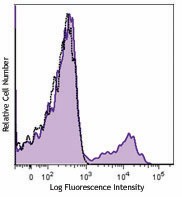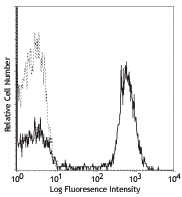- Clone
- J252D4 (See other available formats)
- Regulatory Status
- RUO
- Other Names
- BLR1, MDR15
- Isotype
- Mouse IgG1, κ
- Ave. Rating
- Submit a Review
- Product Citations
- publications

-

Human peripheral blood lymphocytes were stained with purified human CD185 (CXCR5, clone J252D4, filled histogram), or purified mouse IgG1, κ isotype control (open histogram), followed by anti-mouse IgG PE.
| Cat # | Size | Price | Quantity Check Availability | Save | ||
|---|---|---|---|---|---|---|
| 356901 | 25 µg | $112 | ||||
| 356902 | 100 µg | $265 | ||||
CD185, also known as CXCR5, is a 42 kD G-protein coupled receptor with seven transmembrane regions. CXCR5 is expressed by mature B cells, follicular helper T cells, Burkitt’s lymphoma cells and a subset of neurons, and mediates cell migration to the B cell follicles in the secondary lymphoid organs. The ligand of CXCR5 is CXCL13 (BLC).
Product DetailsProduct Details
- Reactivity
- Human
- Antibody Type
- Monoclonal
- Host Species
- Mouse
- Immunogen
- Human CXCR5-transfected cells
- Formulation
- Phosphate-buffered solution, pH 7.2, containing 0.09% sodium azide.
- Preparation
- The antibody was purified by affinity chromatography.
- Concentration
- 0.5 mg/ml
- Storage & Handling
- The antibody solution should be stored undiluted between 2°C and 8°C.
- Application
-
FC - Quality tested
- Recommended Usage
-
Each lot of this antibody is quality control tested by immunofluorescent staining with flow cytometric analysis. For flow cytometric staining, the suggested use of this reagent is ≤0.5 µg per million cells in 100 µl volume. It is recommended that the reagent be titrated for optimal performance for each application.
- Product Citations
- RRID
-
AB_2561810 (BioLegend Cat. No. 356901)
AB_2561811 (BioLegend Cat. No. 356902)
Antigen Details
- Structure
- G-protein coupled receptor, 7 transmembrane regions, 42 kD
- Distribution
-
Mature B cells, Follicular helper T cells, and Burkitt's lymphoma cells.
- Function
- Mediates cell migration to the B cell follicles in the secondary lymphoid organs
- Ligand/Receptor
- CXCL13
- Cell Type
- B cells, Tfh
- Biology Area
- Cell Biology, Immunology, Neuroinflammation, Neuroscience
- Molecular Family
- CD Molecules, Cytokine/Chemokine Receptors, GPCR
- Antigen References
-
1. Ma CS, et al. 2012. J. Exp. Med. 209:1241.
2. León B, et al. 2012. Nat. Immunol. 13:681.
3. Crotty S. 2011. Annu. Rev. Immunol. 29:621.
4. Kerfoot SM, et al. 2011. Immunity 34:947.
5. Sáez de Guinoa J, et al. 2011. Blood 118:1560. - Gene ID
- 643 View all products for this Gene ID
- UniProt
- View information about CD185 on UniProt.org
Related FAQs
- Does staining at room temperature or even at 37°C help for checking chemokine receptors expression?
-
Due to continuous recycling of many chemokine receptors, it may be worthwhile to consider staining at room temperature or at 37°C if the staining at lower temperature (which can potentially reduce receptor turnover) is not optimal.
Customers Also Purchased
Compare Data Across All Formats
This data display is provided for general comparisons between formats.
Your actual data may vary due to variations in samples, target cells, instruments and their settings, staining conditions, and other factors.
If you need assistance with selecting the best format contact our expert technical support team.
 Login/Register
Login/Register 












Follow Us